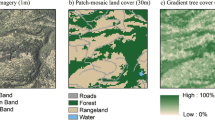Abstract
Mathematical morphology encompasses methods for characterizing land-cover patterns in ecological research and biodiversity assessments. This paper reports a neutral model analysis of patterns in the absence of a structuring ecological process, to help set standards for comparing and interpreting patterns identified by mathematical morphology on real land-cover maps. We considered six structural classes (core, perforated, edge, connector, branch, and patch) on randomly generated binary (forest, non-forest) maps in which the percent occupancy (P) of forest varied from 1% to 99%. The maps were dominated by the patch class for low P, by the branch and connector classes for intermediate P, and by the edge, perforated, and core classes for high P. Two types of pattern phase changes were signaled by abrupt transitions among the six structural classes, at critical P thresholds that were indicated by increased variance among maps for the same P. A phase change from maps dominated by the patch class to maps dominated by the branch and connector classes was related to the existence of a percolating cluster of forest, and the P threshold varied depending on the co-existence of the core class. A second phase change from the edge class to the perforated class was related to the existence of a percolating cluster of non-core (including non-forest) and represents a change of context from exterior to interior. Our results appear to be the first demonstration of multiple phase changes controlling different aspects of landscape pattern on random neutral maps. Potential applications of the results are illustrated by an analysis of ten real forest maps.







Similar content being viewed by others
References
Caswell H (1976) Community structure: a neutral model analysis. Ecol Monogr 46:327–354
Forman RTT (1995) Land mosaics: the ecology of landscapes and regions. Cambridge University Press, Cambridge, UK
Freemark K, Bert D, Villard M-A (2002) Patch-, landscape-, and regional-scale effects on biota. In: Gutzwiller KJ (ed) Applying landscape ecology in biological conservation. Springer-Verlag, New York NY, pp 58–83
Gardner RH (1999) RULE: a program for the generation of random maps and the analysis of spatial patterns. In: Klopatek JM, Gardner RH (eds) Landscape ecological analysis: issues and applications. Springer-Verlag, New York, NY, pp 280–303
Gardner RH, Milne BT, Turner MG, O’Neill RV (1987) Neutral models for the analysis of broad-scale landscape pattern. Landsc Ecol 1:19–28
Gardner RH, O’Neill RV (1991) Pattern, process and predictability: the use of neutral models for landscape analysis. In: Turner MG, Gardner RH (eds) Quantitative methods in landscape ecology. Springer-Verlag, New York, NY, pp 289–308
Geographic Data Technology (2002) Dynamap/2000 user manual. Geographic Data Technology, Inc., Lebanon, NH
Gustafson EJ, Parker GR (1992) Relationships between landcover proportion and indices of landscape spatial pattern. Landsc Ecol 7:101–110
Milne BT (1992) Spatial aggregation and neutral models in fractal landscapes. Am Nat 139:32–57
Nicolis G, Prigogine I (1989) Exploring complexity: an introduction. W.H. Freeman and Company, New York, NY
O’Neill RV, Gardner RH, Turner MG (1992) A hierarchical neutral model for landscape analysis. Landsc Ecol 7:55–61
Pearson SM, Gardner RH (1997) Neutral models: useful tools for understanding landscape patterns. In Bissonette JA (ed) Wildlife and landscape ecology: effects of pattern and scale. Springer-Verlag, New York, NY, pp 215–230
Plotnick RE, Gardner RH (1993) Lattices and landscapes. In: Gardner RH (ed) Lectures on mathematics in the life sciences: predicting spatial effects in ecological systems. American Mathematical Society, Providence, RI, pp 129–157
Riitters KH, Wickham JD, O’Neill RV, Jones KB, Smith ER (2000) Global-scale patterns of forest fragmentation. Ecol Soc 4(2):3
Riitters KH, Wickham JD, Coulston JW (2004) Use of road maps in United States national assessments of forest fragmentation. Ecol Soc 9(2):13
Soille P (2003) Morphological image analysis: principles and applications, 2nd edn. Springer-Verlag, Berlin
Stauffer D, Aharony A (1994) Introduction to percolation theory, 2nd edn. Taylor & Francis, London
Tran LT, O’Neill RV, Smith ER (2006) A generalized distance measure for integrating multiple environmental assessment indicators. Landsc Ecol 21:469–476
Turner MG, Gardner RH, O’Neill RV (2001) Landscape ecology in theory and practice: pattern and process. Springer-Verlag, New York, NY
Vogelmann JE, Howard SM Yang L, Larson CR, Wylie BK, Van Driel N (2001) Completion of the 1990s national land cover data set for the conterminous United States from Landsat Thematic Mapper data and ancillary data sources. Photogram Eng Remote Sensing 67:650–662
Vogt P, Riitters KH, Estreguil C, Kozak J, Wade TG, Wickham JD (2007a) Mapping spatial patterns with morphological image processing. Landsc Ecol 22:171–177. doi: 10.1007/s10980–006-9013-2
Vogt P, Riitters KH, Iwanowski M, Estreguil C, Kozak J, Soille P (2007b) Mapping landscape corridors. Ecol Indic 7:481–488. doi:10.1016/j.ecolind.2006.11.001.
With KA, King AW (1997) The use and misuse of neutral landscape models in ecology. Oikos 79:219–229
Acknowledgments
The research described in this article was performed as a part of the Collaboration Agreement (No. 22832-2005-06 S0SC ISP) between the European Commission - DG Joint Research Centre, Institute for Environment and Sustainability and the United States Department of Agriculture, Forest Service. KR acknowledges support from the Strategic Planning and Resource Assessment Staff, USDA Forest Service.
Author information
Authors and Affiliations
Corresponding author
Additional information
The U.S. Government's right to retain a non-exclusive, royalty-free license in and to any copyright is acknowledged.
Rights and permissions
About this article
Cite this article
Riitters, K.H., Vogt, P., Soille, P. et al. Neutral model analysis of landscape patterns from mathematical morphology. Landscape Ecol 22, 1033–1043 (2007). https://doi.org/10.1007/s10980-007-9089-3
Received:
Accepted:
Published:
Issue Date:
DOI: https://doi.org/10.1007/s10980-007-9089-3




